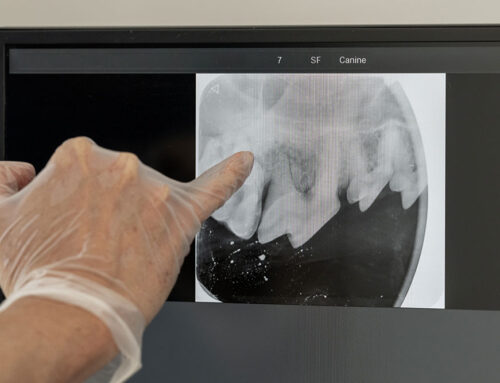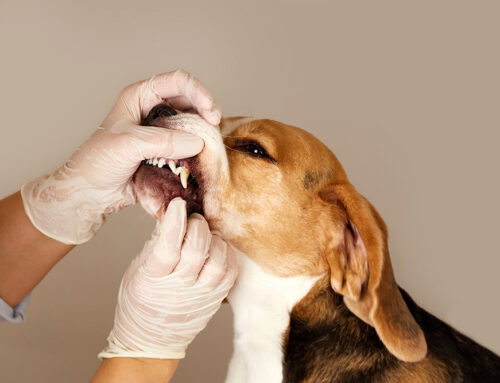Watching a pet retch or race to the litter box is unnerving and heartbreaking.
At Town & Country Animal Hospital in Athens, Alabama, we field calls about vomiting and diarrhea every single day, and we know exactly how distressing these problems feel from the other end of the leash. The good news is that most tummy troubles are short-lived. The not-so-good news is that some are true emergencies that demand immediate medical care.
In this guide, we share the knowledge our team relies on when deciding whether to monitor a pet at home or ask you to head straight to our treatment area.
What Counts as Vomiting and Diarrhea?
- Vomiting is the forceful ejection of stomach or upper-intestinal contents through the mouth.
- Diarrhea is stool that is softer than normal, watery, or explosively liquid.
Gagging and regurgitation (food passively coming back up) may appear similar to vomiting, but it’s important to differentiate because the underlying causes and treatments differ.
Common Triggers We See in North Alabama
- Sudden diet change or “garbage gut.”
- Dietary indiscretion—pan drippings, bacon grease, yard mushrooms.
- Intestinal parasites.
- Viral infection such as Canine parvovirus.
- Bacterial infection picked up from contaminated water or raw meat.
- Pancreatitis after a fatty meal.
- Swallowed objects; a single sock can cause a life-threatening Gastrointestinal Foreign Body Obstruction in Dogs.
- Chronic disorders—kidney disease, inflammatory bowel disease, food allergies.
- Stress: boarding, thunderstorms, house guests.
- Motion sickness.
- Morning bile reflux; read about Bilious Vomiting Syndrome in Dogs if you notice yellow fluid first thing after waking.
Because so many issues look alike at 2 a.m., we encourage you to keep our phone number handy and trust your gut when yours tells you something is off with your pet’s gut.
Red-Flag Signs That Mean “Go Now”
Please phone us or the nearest emergency hospital if you notice:
- Vomiting more than three times in an hour or unrelenting retching.
- Blood—bright red or coffee-ground—in vomit.
- Projectile diarrhea, especially if it is tarry, black, or blood-tinged.
- A painful, distended abdomen.
- Repeated attempts to vomit with nothing coming up.
- Lethargy, collapse, or pale gums.
- Inability to keep water down for six hours.
- Known toxin exposure (chocolate, antifreeze, rat bait).
- High fever or temperature below 99 °F.
Cornell’s Canine Diarrhea Information explains how quickly dehydration can follow fluid loss—sometimes in as little as a few hours in puppies and kittens. When in doubt, err on the side of speed.
What to Expect When You Arrive at Our Hospital
We start with a hands-on examination: capillary refill time, hydration status, abdominal palpation, heart and lung auscultation. Next, we tailor diagnostics to your pet and your budget:
- Complete blood count, chemistry, and electrolytes—review the Importance of Blood Work for Your Dog to see why we rely on these numbers.
- Fecal flotation and Giardia ELISA.
- Abdominal radiographs to check for obstructions or metal.
- Point-of-care ultrasound to visualize intestines and free fluid.
- Parvovirus or panleukopenia test in youngsters.
- Contrast studies or endoscopy if obstruction is suspected; the overview in Exploratory Surgery in Pets explains why surgery is sometimes lifesaving.
Treatment Options We Offer
Supportive care is the cornerstone: intravenous or subcutaneous fluids, anti-nausea medication, antacids, probiotics, and a bland diet. We carry novel-protein and hydrolyzed prescription foods for pets with true food allergies.
If infection is confirmed, targeted antibiotics or dewormers are dispensed. A blocked intestine, perforated ulcer, or bleeding mass requires immediate surgery in our fully equipped suite. Intensive-care hospitalization with round-the-clock monitoring is available for critical patients.
How These Conditions Affect Your Pet’s Body and Mind
Dehydration thickens blood, strains kidneys, and robs cells of oxygen. Electrolyte imbalances may trigger irregular heartbeats and seizures. Severe abdominal pain leads to hunched posture, trembling, and even aggression born of fear. Concurrent anxiety from repeated vomiting can cause your pet to hide, avoid the litter box, or soil the house—behaviors that are frustrating for you and frightening for them.
Early intervention not only improves survival rates but also shortens recovery time and minimizes the emotional toll on everyone involved.
At-Home Care for Mild Upset Stomachs
Some episodes are mild enough to manage under our guidance from home:
- Withhold food for six-to-twelve hours (not water).
- Offer small amounts of water every 30 minutes if vomiting has stopped.
- Transition to a bland diet of boiled chicken breast and white rice for 24–48 hours.
- Feed small, frequent meals.
- Gradually mix the regular diet back over three days.
If appetite still lags the following day, the tips in What to Do If Your Dog Is Not Eating can help—but remember that prolonged anorexia always warrants an exam.
Preventing Future Digestive Emergencies

- Feed a consistent, high-quality diet; introduce new foods over seven days.
- Store trash and compost in pet-proof containers.
- Keep string, hair ties, and small toys off the floor.
- Use monthly parasite preventives and submit fecals twice yearly.
- Vaccinate puppies and kittens on schedule to block parvo and panleukopenia.
- Provide slow-feed bowls for dogs that gulp their meals.
- Address stress triggers—separate meal areas for cats, safe zones during storms, enrichment toys to ward off boredom.
Owners of curious cats can learn more about stool changes in Purina’s Causes and Treatments of Cat Diarrhea, while dog guardians may find the broad overview in Diarrhea in Pets useful for spotting patterns.
Real-Life Scenarios: When Would We Send You Straight In?
- Your eight-month-old Lab swallowed a corn cob and is now gagging foam—high risk of blockage.
- Your two-pound kitten has watery, bloody diarrhea every hour—rapid dehydration is imminent.
- Your senior cat with kidney disease vomits clear fluid twice daily for three days—could signal worsening renal function.
- Your terrier vomited once after a fatty steak and now won’t move, cries when picked up—pancreatitis is likely.
Each situation carries different urgency, but all deserve a conversation with a veterinarian. A single phone call can prevent hours of worry—or save a life.
Frequently Asked Questions
Is occasional vomiting normal?
Not “normal”, but necessarily concerning. Isolated vomiting of hair or grass can be noted but don’t always need action. Repetition of vomiting, unproductive vomiting, blood, or lethargy is not.
Can I give my pet human antacids or anti-diarrheals?
Please don’t. Many human medications contain xylitol, acetaminophen, or salicylates that are toxic to animals.
Do probiotic supplements help?
They often shorten recovery. We can recommend strains backed by veterinary studies.
How do I tell vomit from regurgitation?
Regurgitated food is undigested, cylindrical, and expelled with little effort. Vomit usually contains bile or partially digested matter and is preceded by heaving.
What does cat vomit look like?
Different textures provide clues; review the Types of Cat Vomit chart for helpful photos.
Will fasting a cat harm its liver?
Cats should never go more than 24 hours without calories—doing so risks hepatic lipidosis. If your cat refuses food, call us.
Our Commitment to You and Your Pet
We know that every puddle on the carpet or pile on the kitchen floor brings a jolt of fear, frustration, and concern. Our entire staff—veterinarians, technicians, and client-care representatives—shares your goal: a comfortable, healthy pet and a calm, informed family.
General information, appointment requests, and directions are available anytime on our website. Whether you need reassurance or rapid intervention, we are ready to help—because caring for pets is not just our job, it is our shared passion.







Leave A Comment